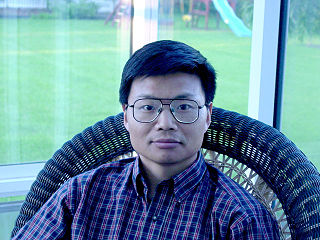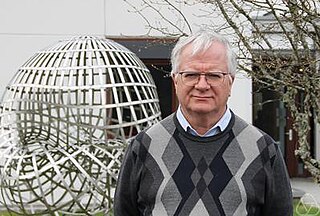Related Research Articles
Computational science,also known as scientific computing,technical computing or scientific computation (SC),is a division of science,and more specifically the Computer Sciences,which uses advanced computing capabilities to understand and solve complex physical problems. While this discussion typically extenuates into Visual Computation,this research field of study will typically include the following research categorizations.
Applied mechanics is the branch of science concerned with the motion of any substance that can be experienced or perceived by humans without the help of instruments. In short,when mechanics concepts surpass being theoretical and are applied and executed,general mechanics becomes applied mechanics. It is this stark difference that makes applied mechanics an essential understanding for practical everyday life. It has numerous applications in a wide variety of fields and disciplines,including but not limited to structural engineering,astronomy,oceanography,meteorology,hydraulics,mechanical engineering,aerospace engineering,nanotechnology,structural design,earthquake engineering,fluid dynamics,planetary sciences,and other life sciences. Connecting research between numerous disciplines,applied mechanics plays an important role in both science and engineering.

James Albert Sethian is a professor of mathematics at the University of California,Berkeley and the head of the Mathematics Group at the United States Department of Energy's Lawrence Berkeley National Laboratory.
Hassan Aref,was the Reynolds Metals Professor in the Department of Engineering Science and Mechanics at Virginia Tech,and the Niels Bohr Visiting Professor at the Technical University of Denmark.

Alexandre Joel Chorin is an American mathematician known for his contributions to computational fluid mechanics,turbulence,and computational statistical mechanics.

Computational Engineering is an emerging discipline that deals with the development and application of computational models for engineering,known as Computational Engineering Models or CEM. Computational engineering uses computers to solve engineering design problems important to a variety of industries. At this time,various different approaches are summarized under the term Computational Engineering,including using computational geometry and virtual design for engineering tasks,often coupled with a simulation-driven approach In Computational Engineering,algorithms solve mathematical and logical models that describe engineering challenges,sometimes coupled with some aspect of AI,specifically Reinforcement Learning.

Thomas Joseph Robert Hughes is a Professor of Aerospace Engineering and Engineering Mechanics and currently holds the Computational and Applied Mathematics Chair (III) at the Oden Institute at The University of Texas at Austin. Hughes has been listed as an ISI Highly Cited Author in Engineering by the ISI Web of Knowledge,Thomson Scientific Company.
Gretar Tryggvason is Department Head of Mechanical Engineering and Charles A. Miller Jr. Distinguished Professor at Johns Hopkins University. He is known for developing the front tracking method to simulate multiphase flows and free surface flows. Tryggvason was the editor-in-chief of Journal of Computational Physics from 2002–2015.
Mohammed Yousuff Hussaini is an Indian born American applied mathematician. He is the Sir James Lighthill Professor of Mathematics and Computational Science &Engineering at the Florida State University,United States. Hussaini is also the holder of the TMC Eminent Scholar Chair in High Performance Computing at FSU. He is widely known for his research in scientific computation,particularly in the field of computational fluid dynamics (CFD) and Control and optimization. Hussaini co-authored the popular book Spectral Methods in Fluid Dynamics with Claudio Canuto,Alfio Quarteroni,and Thomas Zang. He is the editor-in-chief of the journal Theoretical and Computational Fluid Dynamics.

Phillip Colella is an American applied mathematician and a member of the Applied Numerical Algorithms Group at the Lawrence Berkeley National Laboratory. He has also worked at Lawrence Livermore National Laboratory. He is known for his fundamental contributions in the development of mathematical methods and numerical tools used to solve partial differential equations,including high-resolution and adaptive mesh refinement schemes. Colella is a member of the US National Academy of Sciences.
John B. Bell is an American mathematician and the Chief Scientist of the Computational Research Division at the Lawrence Berkeley National Laboratory. He has made contributions in the areas of finite difference methods,numerical methods for low Mach number flows,adaptive mesh refinement,interface tracking and parallel computing. He has also worked on the application of these numerical methods to problems from a broad range of fields,including combustion,shock physics,seismology,flow in porous media and astrophysics.

Weinan E is a Chinese mathematician. He is known for his pathbreaking work in applied mathematics and machine learning. His academic contributions include novel mathematical and computational results in stochastic differential equations;design of efficient algorithms to compute multiscale and multiphysics problems,particularly those arising in fluid dynamics and chemistry;and pioneering work on the application of deep learning techniques to scientific computing. In addition,he has worked on multiscale modeling and the study of rare events.
Marsha J. Berger is an American computer scientist. Her areas of research include numerical analysis,computational fluid dynamics,and high-performance parallel computing. She is a Silver Professor (emeritus) of Computer Science and Mathematics in the Courant Institute of Mathematical Sciences of New York University. She is Group Leader of Modeling and Simulation in the Center for Computational Mathematics at the Flatiron Institute.

Dimitris Drikakis,PhD,FRAeS,CEng,is a Greek-British applied scientist,engineer and university professor. His research is multidisciplinary. It covers fluid dynamics,computational fluid dynamics,acoustics,heat transfer,computational science from molecular to macro scale,materials,machine learning,and emerging technologies. He has applied his research to diverse fields such as Aerospace &Defence,Biomedical,and Energy and Environment Sectors. He received The William Penney Fellowship Award by the Atomic Weapons Establishment to recognise his contributions to compressible fluid dynamics. He was also the winner of NEF's Innovator of the Year Award by the UK's Institute of Innovation and Knowledge Exchange for a new generation carbon capture nanotechnology that uses carbon nanotubes for filtering out carbon dioxide and other gases.
Model order reduction (MOR) is a technique for reducing the computational complexity of mathematical models in numerical simulations. As such it is closely related to the concept of metamodeling,with applications in all areas of mathematical modelling.

Elaine Surick Oran is an American physical scientist and is considered a world authority on numerical methods for large-scale simulation of physical systems. She has pioneered computational technology to solve complex reactive flow problems,unifying concepts from science,mathematics,engineering,and computer science in a new methodology. An incredibly diverse range of phenomena can be modeled and better understood using her techniques for numerical simulation of fluid flows,ranging from the tightly grouped movements of fish in Earth's oceans to the explosions of far-flung supernovae in space. Her work has contributed significantly to the advancement of the engineering profession.
Sara Zahedi is an Iranian-Swedish mathematician who works in computational fluid dynamics and holds an associate professorship in numerical analysis at the Royal Institute of Technology (KTH) in Sweden. She is one of ten winners and the only female winner of the European Mathematical Society Prize for 2016 "for her outstanding research regarding the development and analysis of numerical algorithms for partial differential equations with a focus on applications to problems with dynamically changing geometry". The topic of Zahedi's EMS Prize lecture was her recent research on the CutFEM method of solving fluid dynamics problems with changing boundary geometry,such as arise when simulating the dynamics of systems of two immiscible liquids. This method combines level set methods to represent the domain boundaries as cuts through an underlying uniform grid,together with numerical simulation techniques that can adapt to the complex geometries of grid cells cut by these boundaries.
Carol San Soucie Woodward is an American computational mathematician who works in the Center for Applied Scientific Computing at Lawrence Livermore National Laboratory. She was elected as a fellow of the Society for Industrial and Applied Mathematics (SIAM) in 2017,"for the development and application of numerical algorithms and software for large-scale simulations of complex physical phenomena".

Rémi Abgrall is a French applied mathematician. He is known for his contributions in computational fluid dynamics,numerical analysis of conservation laws,multiphase flow and Hamilton–Jacobi equations. He has been editor in chief of the Journal of Computational Physics since 2015 and is part of the editorial board of several international scientific journals. In 2014 he was invited speaker at the International Congress of Mathematics in Seoul. He is author of more than 100 scientific papers published in international scientific journals. He is editor of 4 books and author of one book on advanced topics concerning computational fluid dynamics,high-resolution schemes and conservation laws.
References
- ↑ Staff profile: Ann S. Almgren, LBL, retrieved 2015-10-09.
- ↑ Taylor, Jean E. (1998), "Frederick Justin Almgren, 1933–1997", The Journal of Geometric Analysis, 8 (5): 679–680, doi:10.1007/BF02922664, MR 1731056, S2CID 122052098 .
- ↑ Almgren, Ann Stewart (1991). A Fast Adaptive Vortex Method in Three Dimensions (PDF) (PhD thesis). University of California at Berkeley. Retrieved November 23, 2024.
- ↑ Curriculum vitae: Ann S. Almgren (PDF), LBL, archived from the original (PDF) on 2016-03-04, retrieved 2015-10-09.
- ↑ SIAM Fellows: Class of 2015, Society for Industrial and Applied Mathematics , retrieved 2015-10-08.
- ↑ "SIREV | Editorial Board | SIAM".
- ↑ "CAMCoS Editorial".